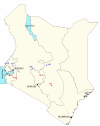An intervention to improve paediatric and newborn care in Kenyan district hospitals: understanding the context
- PMID: 19627588
- PMCID: PMC2724481
- DOI: 10.1186/1748-5908-4-42
An intervention to improve paediatric and newborn care in Kenyan district hospitals: understanding the context
Abstract
Background: It is increasingly appreciated that the interpretation of health systems research studies is greatly facilitated by detailed descriptions of study context and the process of intervention. We have undertaken an 18-month hospital-based intervention study in Kenya aiming to improve care for admitted children and newborn infants. Here we describe the baseline characteristics of the eight hospitals as environments receiving the intervention, as well as the general and local health system context and its evolution over the 18 months.
Methods: Hospital characteristics were assessed using previously developed tools assessing the broad structure, process, and outcome of health service provision for children and newborns. Major health system or policy developments over the period of the intervention at a national level were documented prospectively by monitoring government policy announcements, the media, and through informal contacts with policy makers. At the hospital level, a structured, open questionnaire was used in face-to-face meetings with senior hospital staff every six months to identify major local developments that might influence implementation. These data provide an essential background for those seeking to understand the generalisability of reports describing the intervention's effects, and whether the intervention plausibly resulted in these effects.
Results: Hospitals had only modest capacity, in terms of infrastructure, equipment, supplies, and human resources available to provide high-quality care at baseline. For example, hospitals were lacking between 30 to 56% of items considered necessary for the provision of care to the seriously ill child or newborn. An increase in spending on hospital renovations, attempts to introduce performance contracts for health workers, and post-election violence were recorded as examples of national level factors that might influence implementation success generally. Examples of factors that might influence success locally included frequent and sometimes numerous staff changes, movements of senior departmental or administrative staff, and the presence of local 'donor' partners with alternative priorities.
Conclusion: The effectiveness of interventions delivered at hospital level over periods realistically required to achieve change may be influenced by a wide variety of factors at national and local levels. We have demonstrated how dynamic such contexts are, and therefore the need to consider context when interpreting an intervention's effectiveness.
Figures
References
Grants and funding
LinkOut - more resources
Full Text Sources
Molecular Biology Databases


